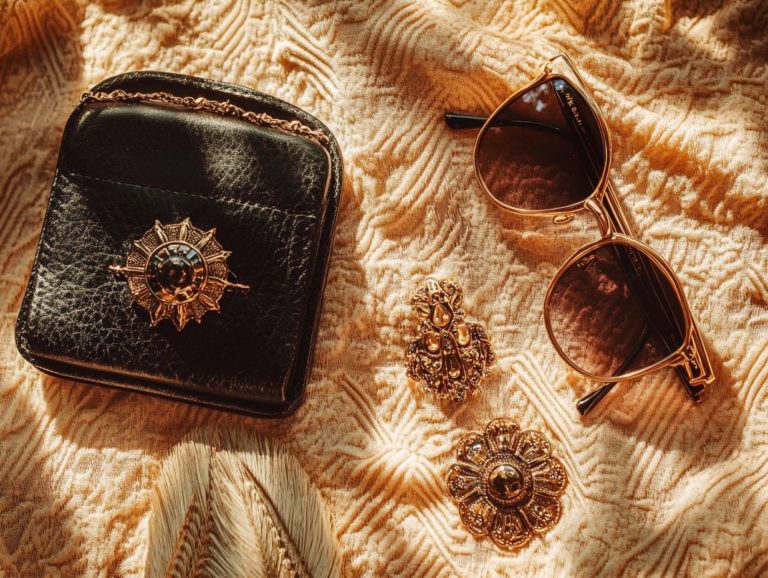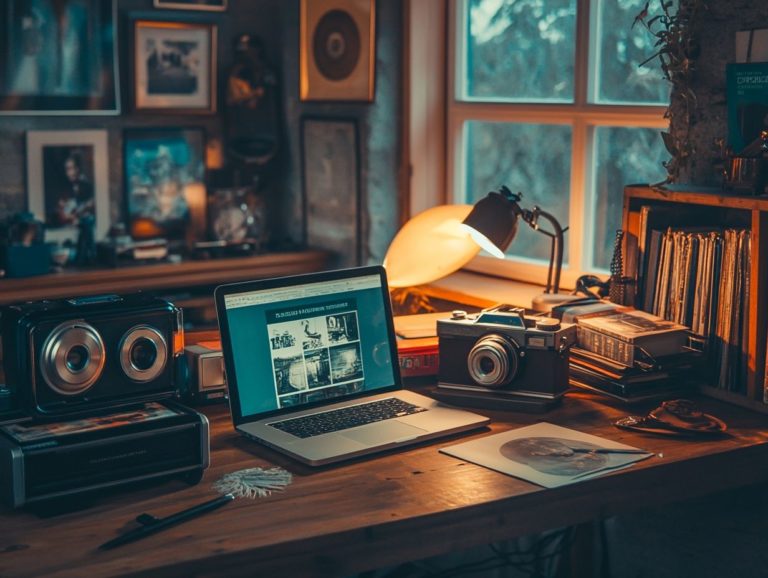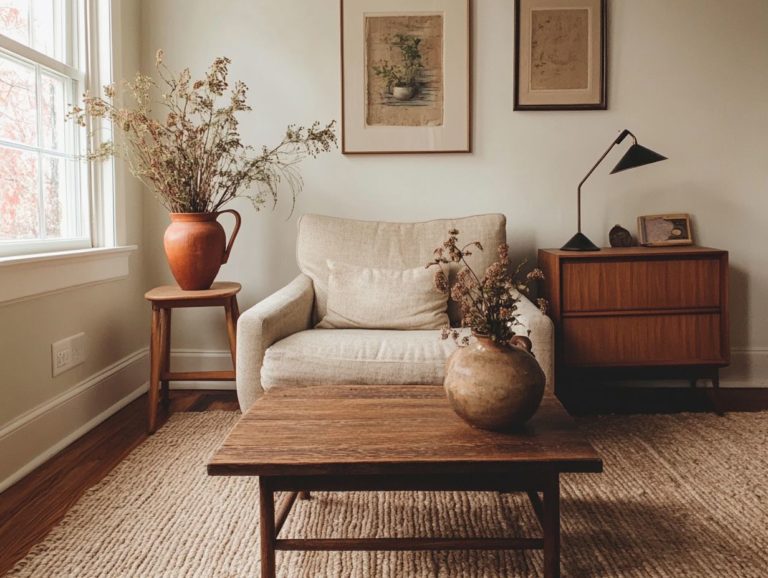How to Spot Fake Vintage Accessories
In today s fashion landscape, vintage accessories exude a unique charm, yet the market is flooded with imitations.
This guide delves into the realm of fake vintage accessories, equipping you with the essential tools to identify them. You ll uncover visual clues and learn to assess materials and construction, empowering you to distinguish authenticity with confidence.
It highlights frequently counterfeited items and brands, offers tips for authenticating your discoveries, and outlines the steps to take should you suspect that you’ve acquired a counterfeit.
Dive in to elevate your expertise as a savvy buyer!
Contents
- Key Takeaways:
- What are Fake Vintage Accessories?
- Signs of Fake Vintage Accessories
- Commonly Faked Vintage Accessories
- How to Avoid Purchasing Fake Vintage Accessories
- What to Do If You Suspect You Have Purchased a Fake
- Frequently Asked Questions
- How Can I Tell If a Vintage Accessory Is Fake?
- What Are Some Common Materials Used in Vintage Accessories?
- How Can I Determine the Authenticity of a Vintage Accessory’s Brand?
- Are There Any Specific Details I Should Look for When Examining a Vintage Accessory?
- Is It Possible for Vintage Accessories to Have Been Altered or Repaired?
- What Should I Do If I Am Unsure About the Authenticity of a Vintage Accessory?
Key Takeaways:
- Look for visual clues like inconsistent logos or poor-quality materials to identify fake vintage accessories.
- Research commonly faked brands and items before making a purchase.
- To avoid purchasing fake vintage accessories, authenticate items and buy from reputable sources.
What are Fake Vintage Accessories?
Fake vintage accessories are items that are misrepresented as authentic vintage, yet they lack the distinctive qualities that truly define genuine pieces. This can manifest in variations in materials, quality of how something is made, and overall aesthetic, creating a deceptive allure that may lead you to believe you re acquiring authentic vintage treasures.
Understanding these details is essential for every collector! It helps you make smart choices and ensures that your acquisitions genuinely reflect the eras they are meant to represent.
Signs of Fake Vintage Accessories
Recognizing the signs of fake vintage accessories is essential for any collector or enthusiast, as it enables you to discern between genuine vintage pieces and those that are skillfully fabricated.
Pay close attention to the condition of each item; the absence of natural signs of aging can be a red flag. Look for inconsistencies in logos or labels and assess the quality of the materials used.
Stay alert for imperfections; they can give you valuable insights into the authenticity of vintage items, ensuring your collection reflects true quality and history.
Visual Clues
Visual clues are often your first indicators to determine whether an accessory is genuinely vintage or a mere counterfeit. Pay close attention to the typography and design elements on vintage clothing labels these details can reveal insights into the item’s era and authenticity. Recognizing the characteristics of original labels and identifying vintage brands will further enable you to distinguish genuine pieces from their counterfeit counterparts.
The typography on vintage labels is not just decorative; it speaks volumes about the fashion trends of specific decades. For instance, the bold, serif fonts of 1960s labels evoke a sense of whimsy and playfulness, while the minimalistic sans-serif style of the 1990s suggests a transition to modernity. Brand logos also carry their own stories. Take Levi’s, for example they ve updated their logo over the years yet still retain a vintage appeal that many collectors covet.
As you explore label designs, notice the intricate details of a vintage Chanel tag. These can tell you a story about authenticity! The intricate detailing of a vintage Chanel tag versus the simpler contemporary versions can serve as a telling sign of authenticity. These elements not only showcase the brand’s history but also assist collectors and enthusiasts in uncovering the fascinating narratives behind each piece.
Ready to start spotting fake vintage accessories? Check out our guide on vintage furniture: how to spot reproductions and embark on your journey today!
Materials and Construction
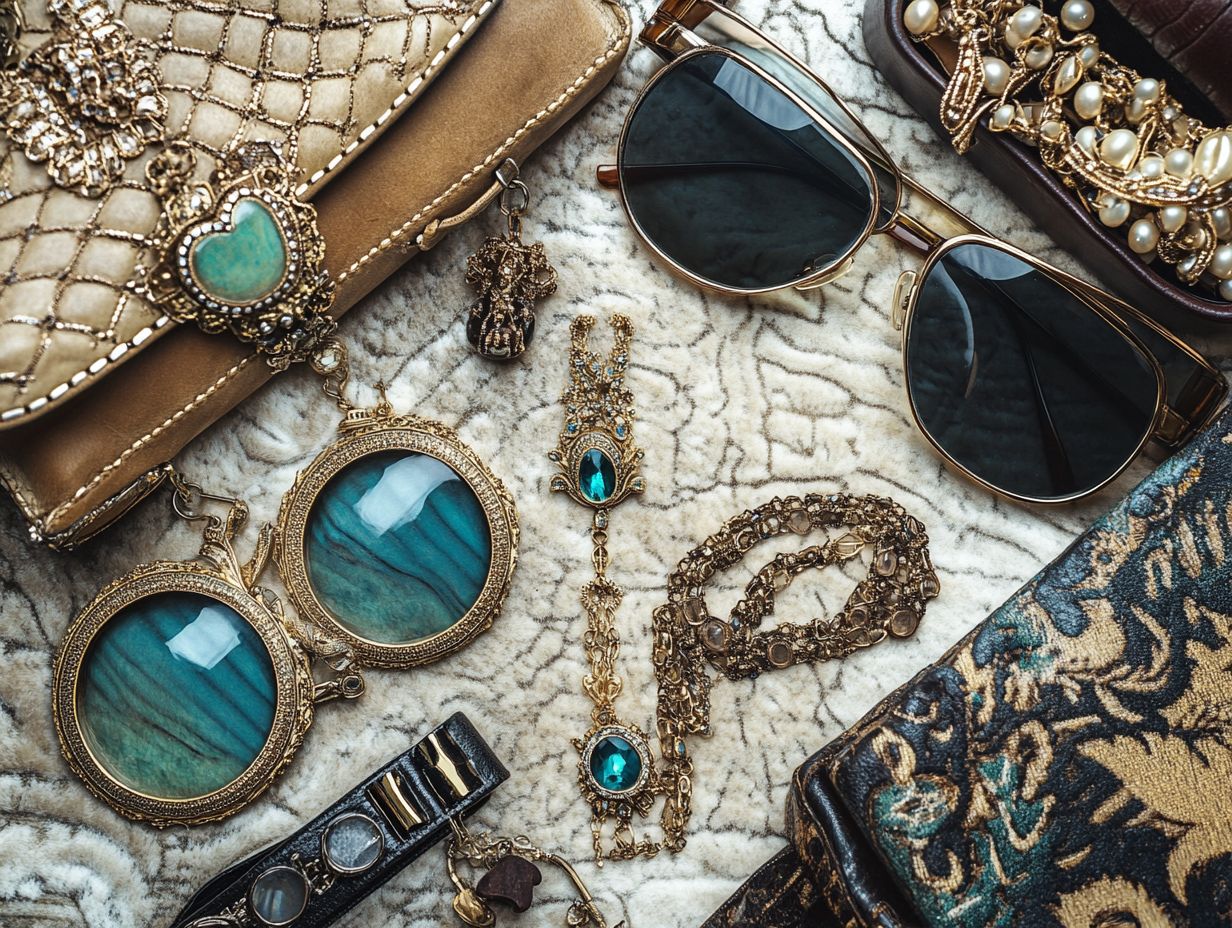
The materials and construction of vintage accessories are crucial in determining their realness and quality. Authentic vintage pieces are typically crafted from high-quality materials that show specific signs of aging, such as a natural patina that enhances their character.
In contrast, counterfeit vintage accessories often rely on inferior materials, missing the distinctive wear that genuine vintage items accumulate over time. Examine for tarnish and other indicators of quality.
When evaluating vintage accessories, look out for materials like genuine leather, solid metals, or authentic gemstones. These can significantly elevate the piece’s value. Pay attention to the stitching; hand-stitched seams usually signify superior quality compared to machine-made alternatives.
Authentic wear, like slight scratches or subtle fading, can indicate a true vintage piece. Overly pristine conditions often hint at a reproduction.
Understanding these details helps you appreciate vintage charm. It also keeps you away from imitations.
Commonly Faked Vintage Accessories
Some vintage accessories are faked more often than others, primarily due to their popularity and allure among collectors. Iconic brands and items like collectible silver and vintage garments from celebrated fashion eras are often imitated, leaving unsuspecting buyers vulnerable.
By knowing which pieces are commonly counterfeited, you can make informed purchasing decisions and navigate vintage shopping with confidence.
Popular Brands and Items
In the vintage market, popular brands and items attract significant attention from collectors, making them prime targets for counterfeiting. Vintage clothing, collectible jewelry, and antique pieces from sought-after brands frequently face replication. Being well-informed about identifying vintage brands and spotting potential fakes is essential to protect your collection.
Chanel, Gucci, and Levi’s are among the most coveted names, each boasting a rich history that adds to the allure of their vintage offerings. Look for specific markers of authenticity like labels, stitching quality, and distinctive design elements that define the originals.
For example, vintage Chanel bags often feature a unique hologram sticker that aids in verification. Reputable platforms offer resources like authentication services and detailed guides, enabling you to make informed decisions while curating your treasured collection.
How to Avoid Purchasing Fake Vintage Accessories
Don t get caught buying fakes! A mix of smart research and careful choices is your best defense.
Authenticate your finds by checking for copyright markings labels that indicate the piece is legally protected inquiring about the item’s history, and buying exclusively from reputable vintage retailers who are transparent about their sourcing practices. Embracing this proactive strategy can greatly reduce your chances of ending up with counterfeit items.
Tips for Authenticating and Buying
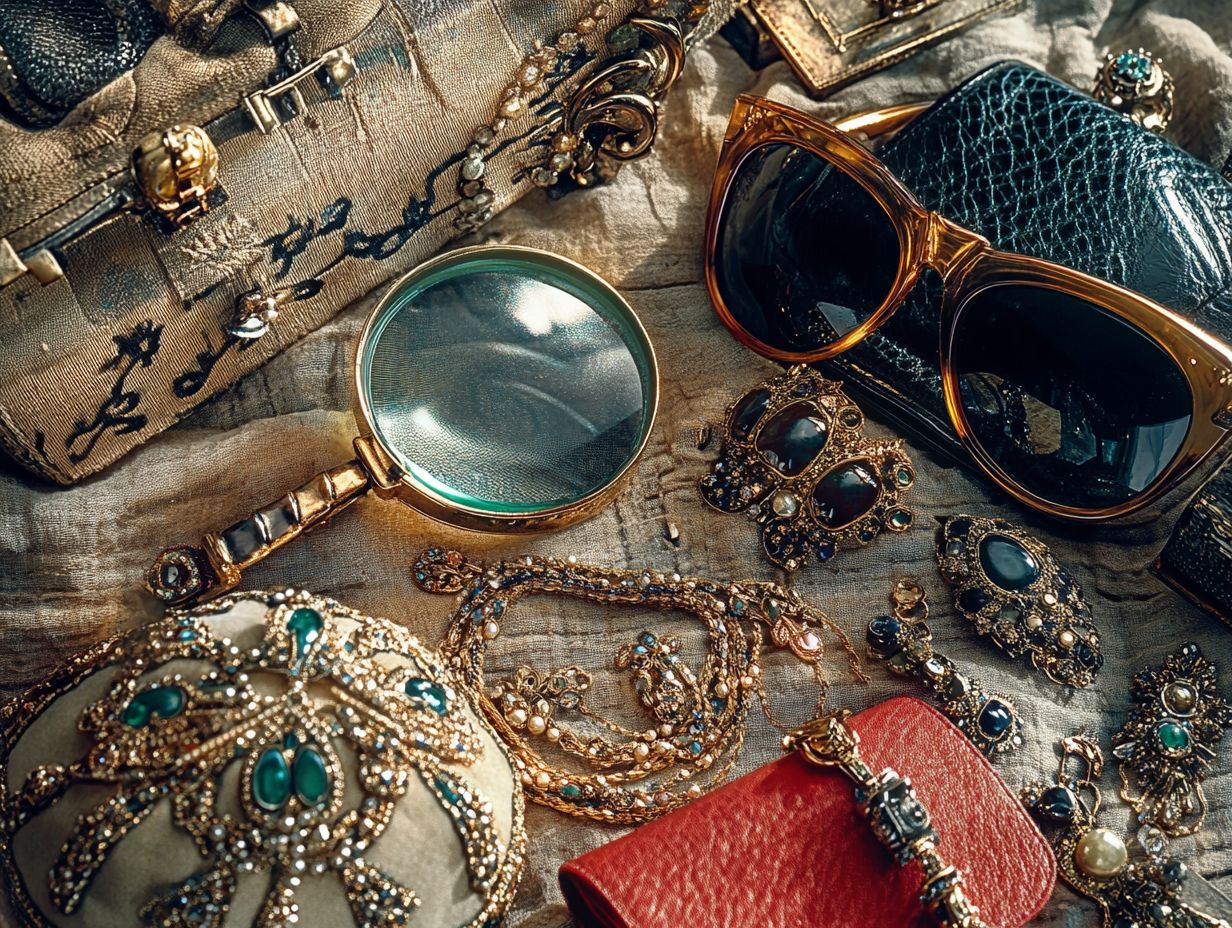
When authenticating and purchasing vintage accessories, follow several tips to ensure a wise investment. Start by examining the logo and label of the item; these details provide significant insights into its authenticity.
Research different fashion eras to appreciate the context of each piece. Recognizing the qualities of genuine antiques will bolster your confidence when making purchases.
Pay close attention to craftsmanship, including stitching and materials used. Reputable manufacturers typically adhere to high standards. Look for signs of wear, which can indicate a piece’s authenticity or age.
Connecting with experienced collectors can provide invaluable perspectives. Reputable online resources can expand your understanding. Don t hesitate to ask sellers for detailed history of ownership; a genuine seller will respect your dedication to due diligence.
Attend vintage fairs or exhibitions to experience items firsthand. This will enhance your learning and refine your skills in recognizing authenticity.
Dive in and start your vintage adventure today! The right piece is waiting for you.
What to Do If You Suspect You Have Purchased a Fake
If you think you bought a fake vintage accessory, act fast to confirm your suspicions and make things right!
Start by carefully inspecting the item for signs like tarnish or imperfections that might indicate it’s not authentic. Seek advice from knowledgeable sources, such as vintage clothing boutiques and expert appraisers, for insights into the true legitimacy of your piece. You might also explore the art of collecting vintage accessories for additional guidance.
Steps to Take and Resources for Help
When you suspect a vintage accessory might be a fake, it’s crucial to take the right steps for resolution. Begin by asking about the item’s history and finding out more about its origins. Reach out to trusted vintage retailers or experts in antique collecting who can help you identify genuine pieces and assess authenticity.
Engage in a constructive dialogue to gather essential information. Experts can verify authenticity and guide you on what details to check. Inquire about the item s production era, any identifying marks, and its previous ownership. Document the accessory’s features with detailed photographs to create a visual record that can aid in your discussions.
Gather any provenance or receipts that could support its history. Clear communication can facilitate valuable exchanges of knowledge, helping you safeguard against potential deceptions.
Frequently Asked Questions
How Can I Tell If a Vintage Accessory Is Fake?
Spotting fakes can be challenging, but there are several signs that can help you.
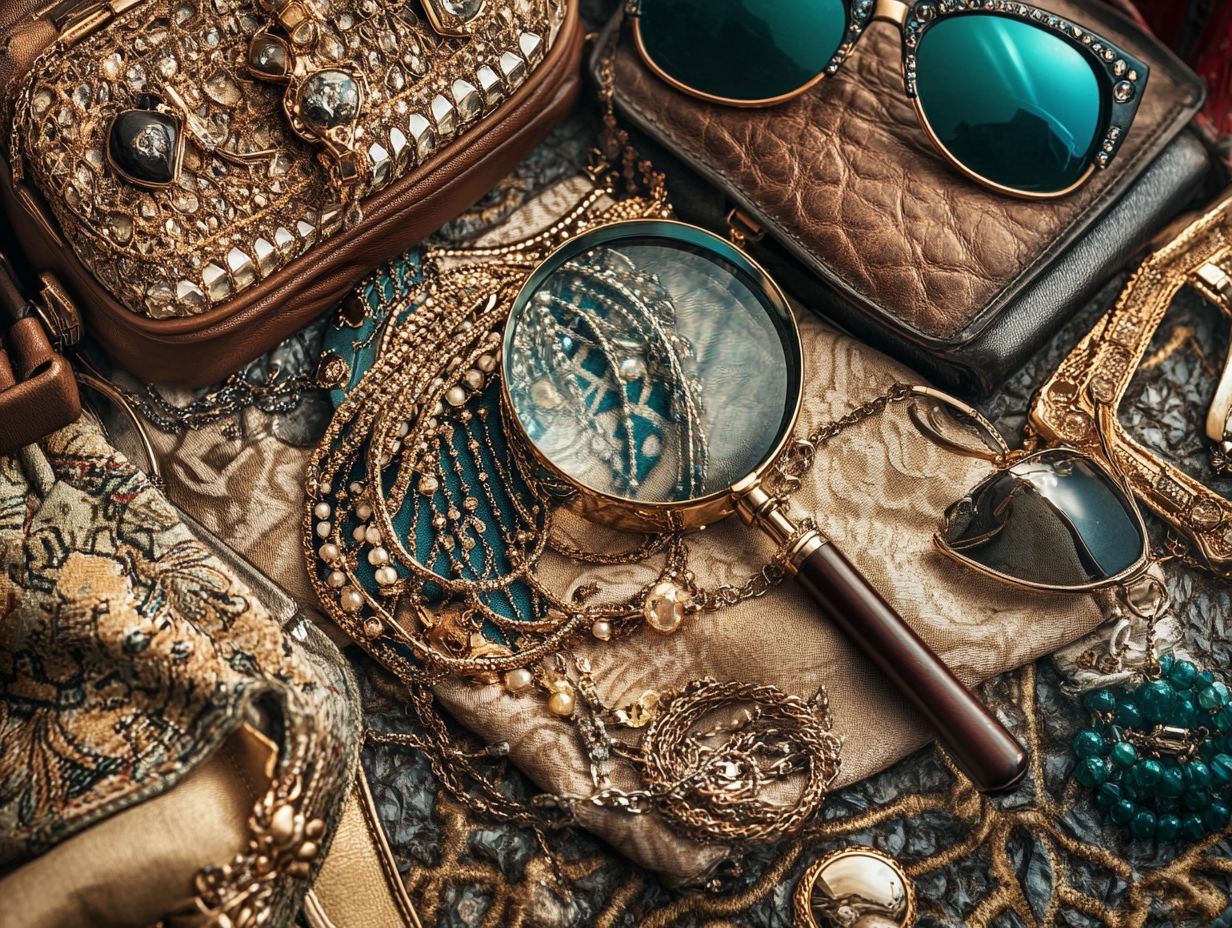
Look for inconsistencies in the style, materials, and branding of the item. Also, pay attention to the overall quality and condition. If it seems too perfect or too worn, it could be a fake.
What Are Some Common Materials Used in Vintage Accessories?
Check the materials used to identify vintage pieces.
Vintage accessories can be made from a variety of materials, including leather, fabric, metal, and plastic. Popular materials during certain periods include Bakelite in the 1930s and Lucite in the 1950s.
How Can I Determine the Authenticity of a Vintage Accessory’s Brand?
To identify vintage brands, thorough research is essential.
Research the brand and its history to determine the authenticity of a vintage accessory. Look for any inconsistencies in the logos, labeling, and dates on the item. Compare the accessory to known authentic pieces from the same brand.
Are There Any Specific Details I Should Look for When Examining a Vintage Accessory?
Besides the obvious features, watch for imperfections that may indicate authenticity.
Yes, certain details can help determine authenticity. These include the stitching, hardware, and any tags or stamps on the item. Pay attention to the level of wear and tear, as true vintage items will show some signs of use.
Is It Possible for Vintage Accessories to Have Been Altered or Repaired?
In some cases, fake antiques might have hidden repairs.
Yes, vintage accessories can be altered or repaired over the years. However, this doesn’t necessarily mean the item is fake. Look for signs of amateur repairs or alterations, as these can indicate that the item is not authentic.
What Should I Do If I Am Unsure About the Authenticity of a Vintage Accessory?
Always ask questions to gain clarity.
If you are unsure about authenticity, consult with an expert or do more research before making a purchase. Ask the seller for more information or photos of the item to help you make a more informed decision.


